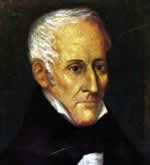Gervasio Antonio de Posadas
Gervasio Antonio de Posadas | |
|---|---|
 | |
| Supreme Director of the United Provinces of the Río de la Plata | |
| In office 31 January 1814 – 9 January 1815 | |
| Preceded by | Second Triumvirate |
| Succeeded by | Carlos María de Alvear |
| Personal details | |
| Born | 18 June 1757 Buenos Aires |
| Died | 2 July 1833 (aged 76) Buenos Aires |
| Nationality | Argentine |
| Profession | Lawyer |
Gervasio Antonio de Posadas y Dávila (18 June 1757, in Buenos Aires – 2 July 1833, in Buenos Aires) was a member of Argentina's Second Triumvirate from 19 August 1813 to 31 January 1814, after which he served as Supreme Director until 9 January 1815.
Posadas' early studies were at the convent of San Francisco. Then he studied and practiced law with Manuel José de Labardén. In 1789 Posadas was appointed notary general for the bishopric, and held that post until the events of the May Revolution. He was unaware of the impending revolution and was caught by surprise when the Buenos Aires Cabildo (town hall) was occupied on 25 May 1810; he did not agree that it had been legitimately done. His donations to the Sociedad Patriótica made him an associate of the Saavedrist faction, so the leaders of the riots of 5 April 1811 exiled him to Mendoza. A month later he was appointed solicitor-procurator for the City of Buenos aires.
Like many other nineteenth century Argentines prominent in public life, Posadas was a freemason.[1]
The Second Triumvirate commissioned Posadas, Nicolás Rodríguez Peña and Juan Larrea to draft a Constitution for consideration by the Asamblea del Año XIII, then he became part of the Triumvirate when the Assembly granted Executive Power to the Triumvirate. Then on 22 January 1814 the same Assembly decided to concentrate the Executive Power in him as a Supreme Director for the United Provinces, and so he took that office for a one-year period. During his rule, Saavedra and Campana were exiled, Montevideo fell to the United Provinces but serious problems arose with José Gervasio Artigas and the Liga Federal on the Banda Oriental. Moreover, Ferdinand VII of Spain regained his throne in 1815.
Posadas was succeeded in office by his nephew, Carlos María de Alvear, who was removed soon afterwards by a military coup d'état. By August 1815 the whole Alvearista faction was in disgrace and Posadas was jailed. The former Supreme Director spent the next six years in 22 different jails. He began writing his memoirs in 1829.
Notes
[edit]This article includes a list of general references, but it lacks sufficient corresponding inline citations. (May 2013) |
- ^ The list includes Juan Bautista Alberdi, Manuel Alberti, Carlos María de Alvear, Miguel de Azcuénaga, Antonio González de Balcarce, Manuel Belgrano, Antonio Luis Beruti, Juan José Castelli, Domingo French, Gregorio Aráoz de Lamadrid, Francisco Narciso de Laprida, Juan Larrea, Juan Lavalle, Vicente López y Planes, Bartolomé Mitre, Mariano Moreno, Juan José Paso, Carlos Pellegrini, Gervasio Antonio de Posadas, Domingo Faustino Sarmiento, and Justo José de Urquiza. José de San Martín is known to have been a member of the Lautaro Lodge; but whether the lodge was truly masonic has been debated: Denslow, William R. (1957). 10,000 Famous Freemasons. Vol. 1–4. Richmond, VA: Macoy Publishing & Masonic Supply Co Inc.
References
[edit]![]() Media related to Gervasio Antonio de Posadas at Wikimedia Commons
Media related to Gervasio Antonio de Posadas at Wikimedia Commons
- 1757 births
- 1833 deaths
- Lawyers from Buenos Aires
- 19th-century Argentine lawyers
- Supreme Directors of the United Provinces of the Río de la Plata
- Members of Argentine triumvirates
- Argentine Freemasons
- 18th-century Argentine lawyers
- People from the Viceroyalty of the Río de la Plata
- Argentine history stubs
- Argentine politician stubs

